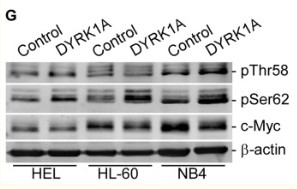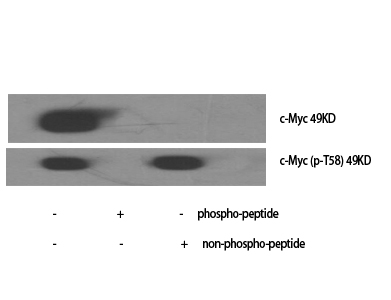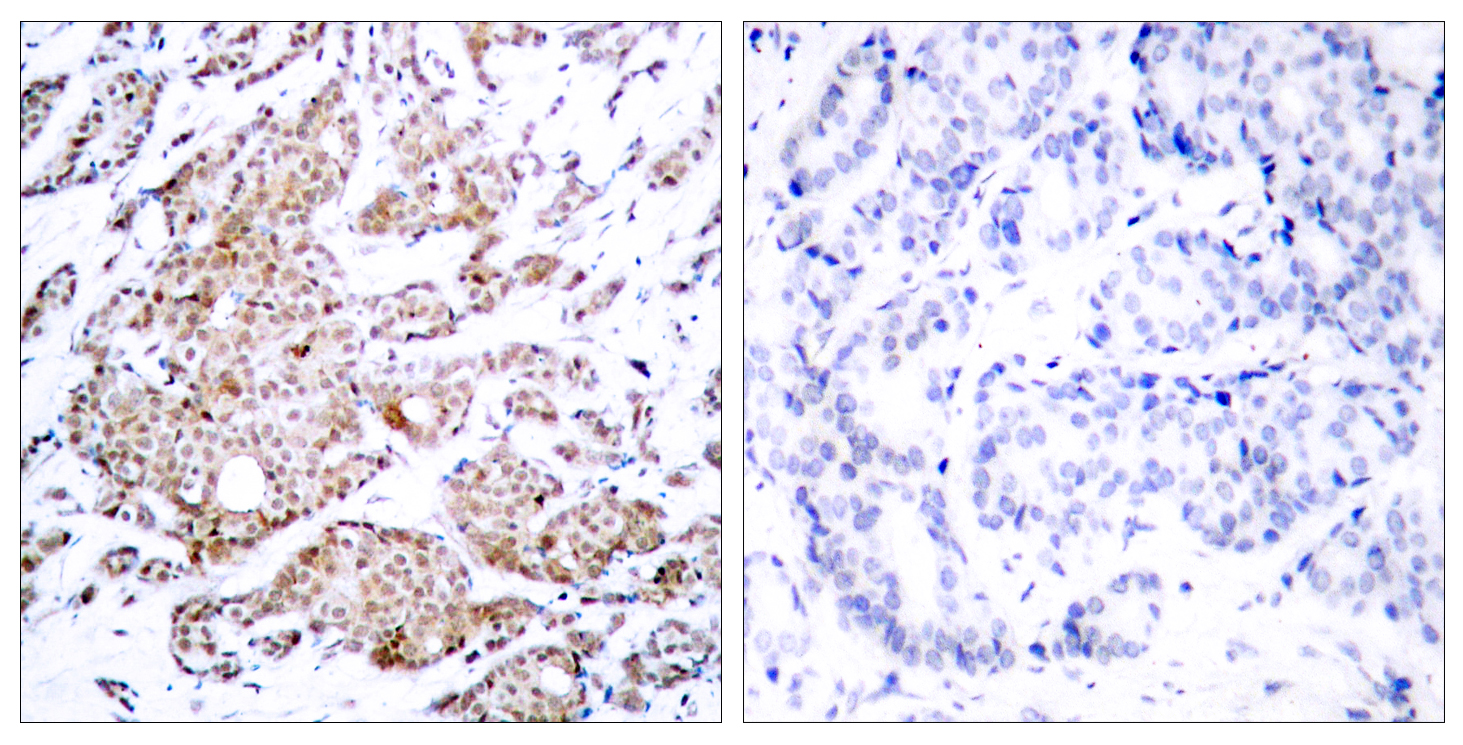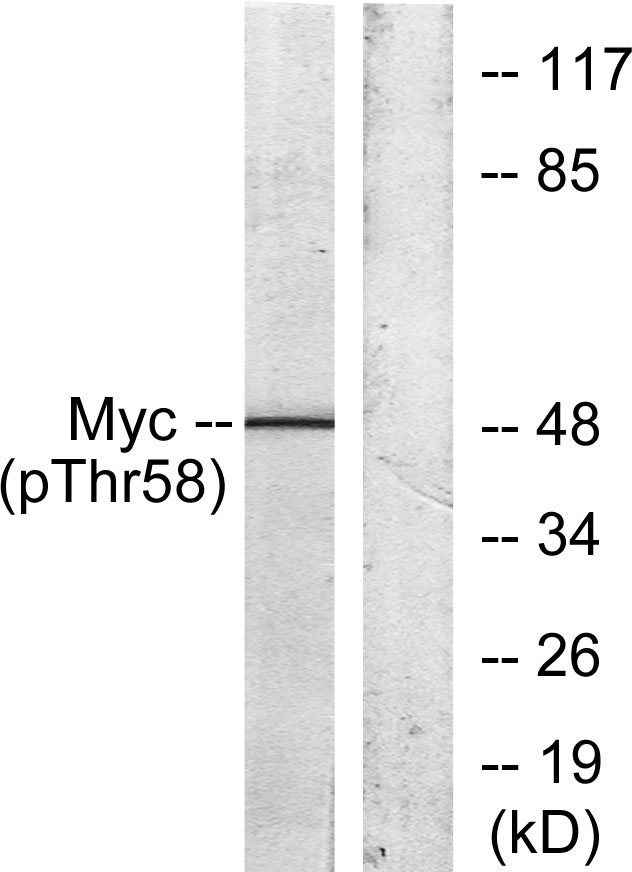c-Myc (phospho Thr58) Polyclonal Antibody
- Catalog No.:YP0069
- Applications:WB;IHC;IF;IP;ELISA
- Reactivity:Human;Mouse;Rat
- Target:
- c-Myc
- Fields:
- >>MAPK signaling pathway;>>ErbB signaling pathway;>>Cell cycle;>>PI3K-Akt signaling pathway;>>Cellular senescence;>>Wnt signaling pathway;>>TGF-beta signaling pathway;>>Hippo signaling pathway;>>Signaling pathways regulating pluripotency of stem cells;>>JAK-STAT signaling pathway;>>Thyroid hormone signaling pathway;>>Salmonella infection;>>Hepatitis C;>>Hepatitis B;>>Human cytomegalovirus infection;>>Human T-cell leukemia virus 1 infection;>>Kaposi sarcoma-associated herpesvirus infection;>>Epstein-Barr virus infection;>>Pathways in cancer;>>Transcriptional misregulation in cancer;>>Proteoglycans in cancer;>>MicroRNAs in cancer;>>Chemical carcinogenesis - receptor activation;>>Colorectal cancer;>>Endometrial cancer;>>Thyroid cancer;>>Bladder cancer;>>Chronic myeloid leukemia;>>Acute myeloid leukemia;>>Small cell lung cancer;>>Breast cancer;>>Hepatocellular carcinoma;>>Gastric cancer;>>Central carbon metabolism in cancer
- Gene Name:
- MYC
- Protein Name:
- Myc proto-oncogene protein
- Human Gene Id:
- 4609
- Human Swiss Prot No:
- P01106
- Mouse Gene Id:
- 17869
- Mouse Swiss Prot No:
- P01108
- Rat Gene Id:
- 24577
- Rat Swiss Prot No:
- P09416
- Immunogen:
- The antiserum was produced against synthesized peptide derived from human Myc around the phosphorylation site of Thr58. AA range:25-74
- Specificity:
- Phospho-c-Myc (T58) Polyclonal Antibody detects endogenous levels of c-Myc protein only when phosphorylated at T58.
- Formulation:
- Liquid in PBS containing 50% glycerol, 0.5% BSA and 0.02% sodium azide.
- Source:
- Polyclonal, Rabbit,IgG
- Dilution:
- WB 1:500 - 1:2000. IHC 1:100 - 1:300. Immunoprecipitation: 2-5 ug:mg lysate. ELISA: 1:10000.. IF 1:50-200
- Purification:
- The antibody was affinity-purified from rabbit antiserum by affinity-chromatography using epitope-specific immunogen.
- Concentration:
- 1 mg/ml
- Storage Stability:
- -15°C to -25°C/1 year(Do not lower than -25°C)
- Other Name:
- MYC;BHLHE39;Myc proto-oncogene protein;Class E basic helix-loop-helix protein 39;bHLHe39;Proto-oncogene c-Myc;Transcription factor p64
- Observed Band(KD):
- 50,(also ~60KD in some samples)
- Background:
- The protein encoded by this gene is a multifunctional, nuclear phosphoprotein that plays a role in cell cycle progression, apoptosis and cellular transformation. It functions as a transcription factor that regulates transcription of specific target genes. Mutations, overexpression, rearrangement and translocation of this gene have been associated with a variety of hematopoietic tumors, leukemias and lymphomas, including Burkitt lymphoma. There is evidence to show that alternative translation initiations from an upstream, in-frame non-AUG (CUG) and a downstream AUG start site result in the production of two isoforms with distinct N-termini. The synthesis of non-AUG initiated protein is suppressed in Burkitt's lymphomas, suggesting its importance in the normal function of this gene. [provided by RefSeq, Jul 2008],
- Function:
- disease:A chromosomal aberration involving MYC may be a cause of a form of B-cell chronic lymphocytic leukemia. Translocation t(8;12)(q24;q22) with BTG1.,disease:Overexpression of MYC is implicated in the etiology of a variety of hematopoietic tumors.,function:Participates in the regulation of gene transcription. Binds DNA both in a non-specific manner and also specifically to recognizes the core sequence 5'-CAC[GA]TG-3'. Seems to activate the transcription of growth-related genes.,online information:Myc entry,PTM:Phosphorylated by PRKDC.,similarity:Contains 1 basic helix-loop-helix (bHLH) domain.,subunit:Efficient DNA binding requires dimerization with another bHLH protein. Binds DNA as a heterodimer with MAX. Interacts with TAF1C and SPAG9. Interacts with PARP10. Interacts with KDM5A and KDM5B.,
- Subcellular Location:
- Nucleus, nucleoplasm . Nucleus, nucleolus .
- Expression:
- Cervix,Epithelium,Leukemia,Placenta,Promyelocytic l
Tumor Suppressor DYRK1A Effects on Proliferation and Chemoresistance of AML Cells by Downregulating c-Myc. PLoS One 2014 Jun 05 WB Human HEL cell, HL-60 cell, NB4 cell
Novel Agent Nitidine Chloride Induces Erythroid Differentiation and Apoptosis in CML Cells through c-Myc-miRNAs Axis. PLoS One 2015 Feb 03 WB Human K562 cell
- June 19-2018
- WESTERN IMMUNOBLOTTING PROTOCOL
- June 19-2018
- IMMUNOHISTOCHEMISTRY-PARAFFIN PROTOCOL
- June 19-2018
- IMMUNOFLUORESCENCE PROTOCOL
- September 08-2020
- FLOW-CYTOMEYRT-PROTOCOL
- May 20-2022
- Cell-Based ELISA│解您多样本WB检测之困扰
- July 13-2018
- CELL-BASED-ELISA-PROTOCOL-FOR-ACETYL-PROTEIN
- July 13-2018
- CELL-BASED-ELISA-PROTOCOL-FOR-PHOSPHO-PROTEIN
- July 13-2018
- Antibody-FAQs
- Products Images

- Liu, Qiang, et al. "Tumor suppressor DYRK1A effects on proliferation and chemoresistance of AML cells by downregulating c-Myc." PloS one 9.6 (2014): e98853.

- Western Blot analysis of various cells using Phospho-c-Myc (T58) Polyclonal Antibody diluted at 1:500
.jpg)
- Western Blot analysis of 293 cells using Phospho-c-Myc (T58) Polyclonal Antibody diluted at 1:500

- Immunohistochemistry analysis of paraffin-embedded human breast carcinoma, using Myc (Phospho-Thr58) Antibody. The picture on the right is blocked with the phospho peptide.

- Western blot analysis of lysates from ovary cancer, using Myc (Phospho-Thr58) Antibody. The lane on the right is blocked with the phospho peptide.



